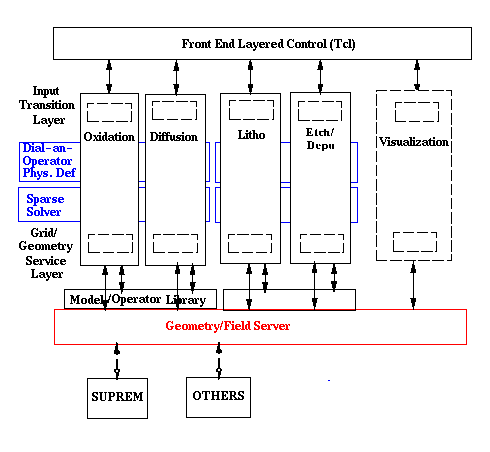SupremOO7:
Agent-based TCAD Development Environment

Principal Investigators
Project Leader
Related Information
Objective
Suprem OO7 is not only a process simulation tool (as is the present release),
but to provide a flexible plug-and-play environment for 1-2-3D
TCAD tool builders.
New utilities such as gridder and geometry engine, new physical models,
new numerical discretization and new linear and non-linear solvers can
be integrated into the environment easily. OO7 takes its names from
three perspectives:
- deep OO (Object-Oriented) methodology used
throughout the software preserving maximum possible efficiency,
- AGENT-based (plug and play) environment
- maintaining all capabilities in Suprem 3 and 4 (3+4=7).
Approach
The main architecture is shown below the title. All servers and solvers
have clearly defined applicational procedural interface (API).
- Minimal SWR Specification for
1-2-3D Geometry/Grid server.
- ALAMODE
(A LAyered MODel Environment): dial-an-operator
PDE definition, currently under construction.
- Unified user interface: tcl-based user interface, currently
under construction.
- Visualizer: based on HDF-Vset or AVS, under construction.
Names, History and Related Tools
The name OO7 is not only a coincidence with
James Bond as a powerful secret agent to symbolize
the plug-and-play integration capabilities, but also stands for its
use of latest Object-Oriented Programming techniques
for its design. The number 7 symbolizes 3+4, which means that all of the
capabilities in Suprem 3 and 4 (and in the future genuine and quasi
3D capabilities) will be provided.
The API between the physical tools
(ALAMODE,
SUPREM,
SPEEDIE,
FOREST, CAMINO, etc.) is the
Minimal SWR Specification.
The API between the physical tools and the unified user interface is
still under development. Some of the preliminary ideas can be found
in the tcl user interface of ALAMODE.
There are more functions provided by the Suprem OO7 framework for building
new tools. The dial-an-operator finite element approach used in
ALAMODE can be applied to other
PDE systems. The suite of linear solvers, both direct and iterative,
with serial/parallel and matrix/matrix-free techniques can be then linked
in the same way as ALAMODE.
Most of the new physical tools are built with support from the ARPA
SprintCAD and SRC
SUPREM projects.
Information modeling of the entire TCAD hierarchy has been performed
under the ARPA Computational Prototyping for 21st Century Semiconductors project.
Edwin C. Kan
kan@gloworm.stanford.edu
201 AEL, Stanford University, Stanford, CA 94305
Office: (415)723-9796
Fax: (415)725-7731

